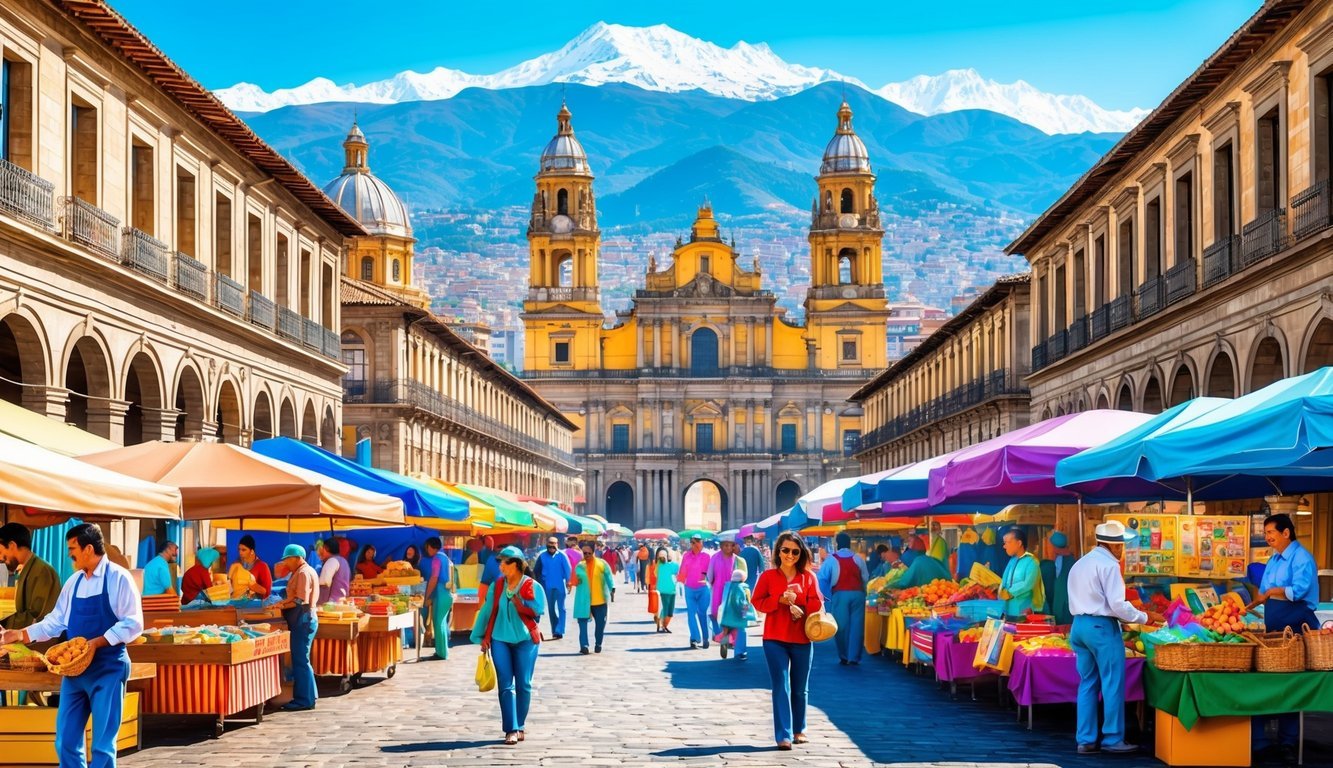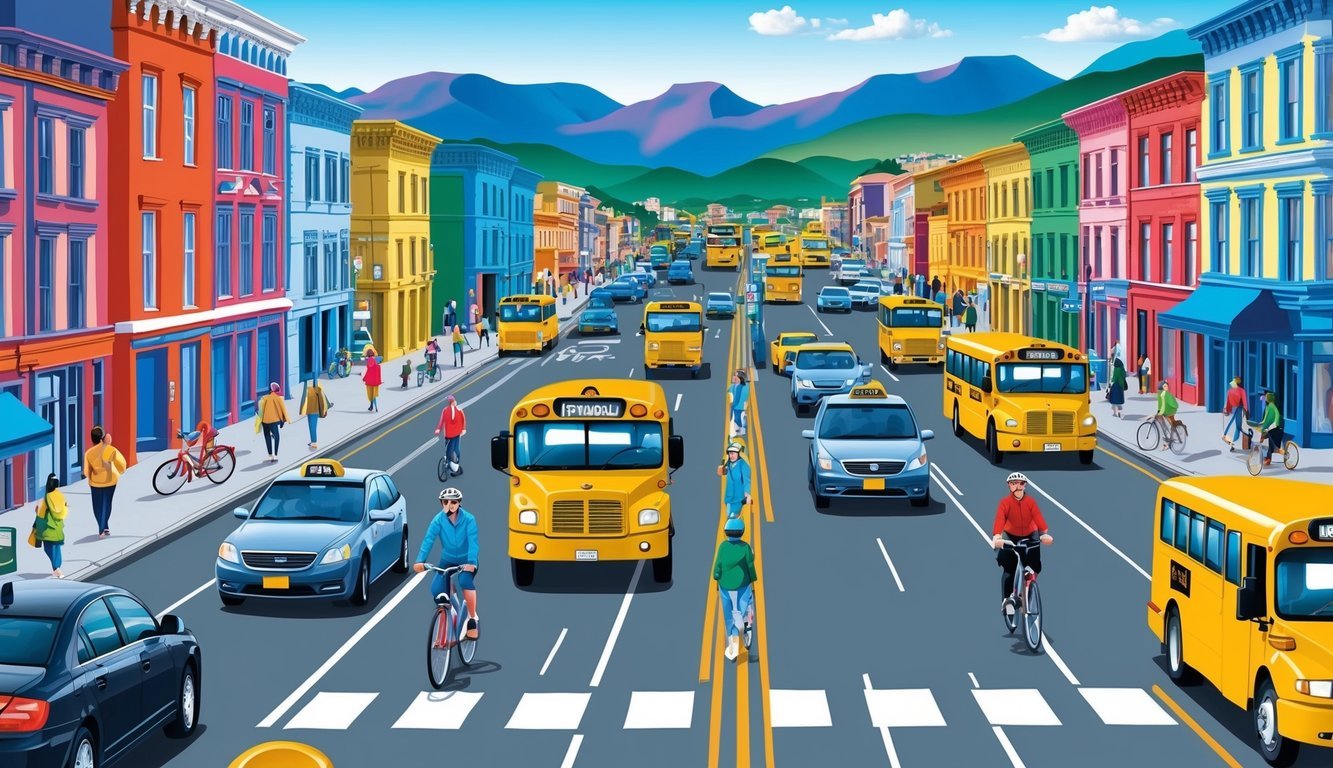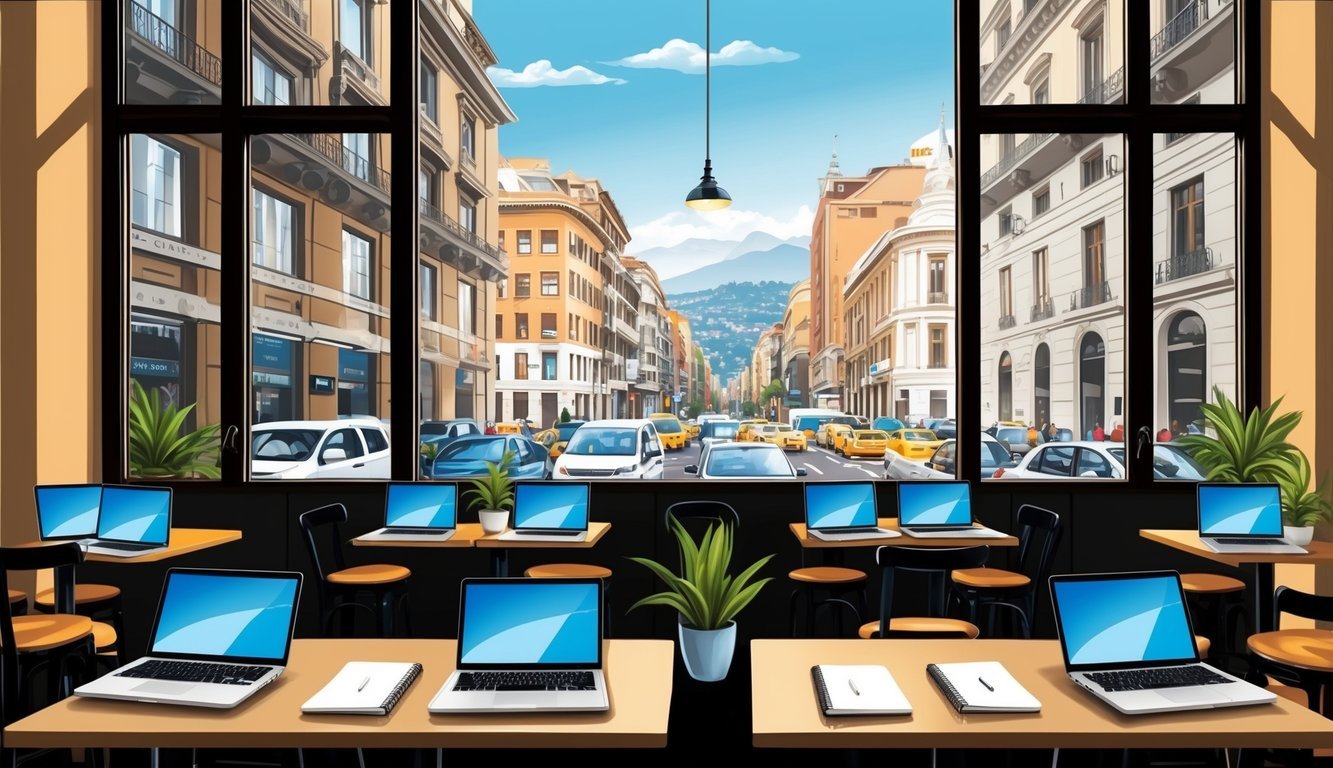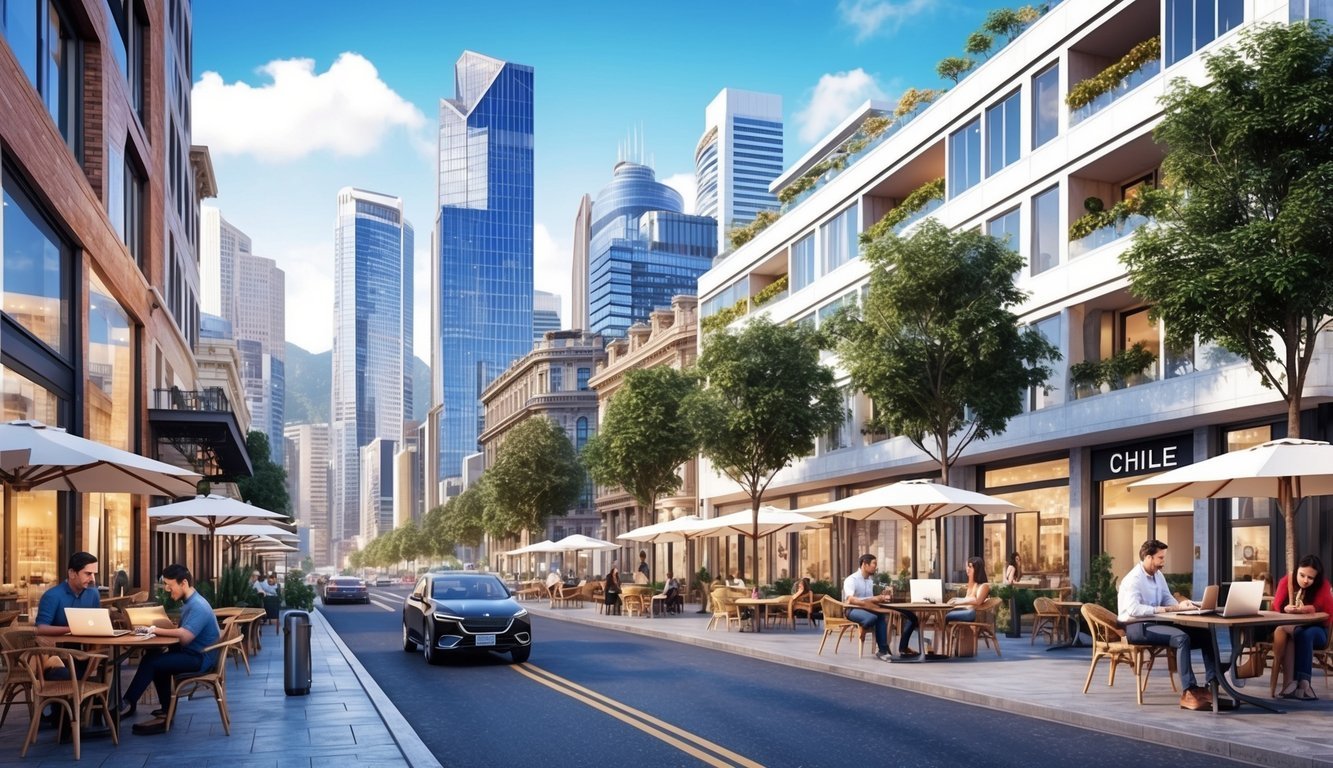Santiago, the capital of Chile, is an exciting destination for digital nomads.
It offers a mix of reliable internet, a vibrant culture, and stunning landscapes.
The city’s Mediterranean climate means you can enjoy mostly sunny days while exploring its unique neighborhoods or grabbing a coffee in local cafes.
From fast internet speeds to a thriving community of like-minded individuals, Santiago provides an excellent environment for remote work.
You can also find a variety of leisure activities, whether you’re into hiking in the Andes or enjoying the local gastronomy.
With so much to offer, this city might just be your next favorite spot for living and working abroad.
Key Takeaways
- Santiago is ideal for remote work with its strong internet and startup scene.
- You can enjoy a great quality of life at a reasonable cost.
- The city offers a rich culture that enhances both work and leisure experiences.
Santiago at a Glance
Santiago is a city full of life and will impress you with its unique mix of geography, climate, and culture.
Knowing more about these aspects can help you settle in and enjoy your time in this vibrant place.
Geography and Climate
Santiago lies between the majestic Andes mountains and the Pacific Ocean.
This stunning backdrop makes for breathtaking views wherever you go.
The city’s elevation sits around 1,700 feet, providing a slightly cooler atmosphere.
Santiago experiences a Mediterranean climate.
Summers are usually hot and dry, while winters can get chilly with some rain.
During summer, temperatures often reach 90°F, while winter lows can drop to around 40°F. This climate allows for plenty of outdoor activities year-round.
Language and Culture
Spanish is the main language spoken in Santiago.
While you may find some locals who speak English, learning a few basic phrases in Spanish can go a long way.
It shows respect for the local culture and helps you connect with the people.
The local culture is a fascinating blend of traditional and modern influences.
Santiago is known for its vibrant arts scene, delicious cuisine, and rich historical heritage.
You can explore museums, street art, and local markets that reflect the city’s unique charm.
Don’t miss trying local dishes like empanadas and pastel de choclo to truly embrace the culinary side of Santiago.
Digital Nomad Essentials
When you decide to work remotely in Santiago, there are a few key things you’ll need to know.
This includes understanding your visa options and ensuring you have reliable internet access.
These essentials will help you settle in smoothly.
Visa and Legalities
To work as a digital nomad in Chile, you’ll generally use a Tourist Visa.
This visa allows you to stay for up to 90 days and is usually issued upon arrival.
It’s important to check if your nationality requires any additional documents.
If you’re planning to stay longer, you may consider applying for a Temporary Resident Visa.
This option can be more complex but allows for extended stays.
Always ensure you understand the legal requirements to avoid any issues.
Check with local authorities for updates, as rules can change frequently.
You’ll want to stay informed to keep your experience hassle-free.
Internet and Connectivity
Santiago offers high-speed internet, making it a great spot for remote work.
The average download speed is about 217.43 Mbps, which is perfect for video calls or downloading large files.
For convenience, many cafes and co-working spaces provide free Wi-Fi.
If you’re on the go, consider getting an eSIM for your mobile device.
This allows you to stay connected without needing a physical SIM card.
Before you arrive, research local providers to find the best data plans that suit your needs.
Reliable internet access will keep you productive and connected during your stay.
Cost and Quality of Living
Living in Santiago offers a mix of affordability and a good quality of life.
With numerous options for accommodation and daily expenses, you can find a lifestyle that suits your budget.
Let’s break down the essentials.
Accommodation Options
When it comes to places to stay, Santiago has plenty of choices.
If you’re looking for something budget-friendly, shared apartments could cost you around $300 to $600 per month.
For more privacy, a one-bedroom apartment will set you back about $463 to $700 monthly, depending on the neighborhood.
Areas like Bellavista and Providencia are popular among expats and digital nomads.
They offer a vibrant local scene and are well-connected, making it easy to explore the city.
Do keep in mind that if you want a furnished apartment, the price might go up.
Daily Expenses
Daily expenses in Santiago are generally more affordable compared to other major South American cities.
You can grab a meal for around $9.12, while coffee is about $2.66.
If you prefer dining out, you might spend approximately $30 to $40 for a nice meal for two.
Public transportation is also budget-friendly, with a metro ride costing around $1.10.
Utilities for apartments can vary, but many find them lower than expected.
Don’t forget to budget for internet costs, which are usually around $30 per month.
Health and Safety
Safety is an important factor when living in a new city.
Santiago has its risks, such as protests and demonstrations, but most areas are safe for daily activities.
The city has a decent healthcare system, and you can find both public and private medical services.
Many expats opt for private health insurance to access better care.
When choosing where to live, it’s wise to research neighborhoods beforehand.
Stick to areas with a good reputation, and you’ll likely have a smoother experience while enjoying life in this vibrant city.
Being aware of your surroundings and taking basic precautions can go a long way in ensuring your safety.
Work and Collaboration
When it comes to working in Santiago, you’ll find plenty of options to connect, collaborate, and get things done.
The city boasts vibrant coworking spaces and numerous networking opportunities to help fuel your remote work experience.
Here’s what you need to know.
Coworking Spaces
Santiago offers a range of coworking spaces that cater to different styles and needs.
For a dynamic atmosphere, check out Ideas Factory.
It’s known for fostering creativity and collaboration among remote workers.
Espacio BA stands out with its modern facilities and great location.
It provides fast Wi-Fi and meeting rooms, perfect for team projects. El Timbre is another popular spot.
It features a cozy vibe and offers a variety of membership plans.
If you’re looking for something unique, Nube Cowork combines a relaxed environment with professional amenities.
Most spaces also host workshops and events, making it easier to meet fellow digital nomads and creatives while keeping productivity high.
Networking Opportunities
Santiago has a thriving community for networking.
Numerous meetups and events happen regularly, focusing on various fields from tech to design.
You can easily find groups on platforms like Meetup.com or Facebook.
These events provide a great chance to connect with locals and other nomads.
Joining coworking spaces often leads to informal networking, too.
You might strike up a conversation in the break room or during an event.
Many spaces also offer monthly networking events, like Friday Meetups, where you can share ideas and collaborate.
Whether you’re looking to brainstorm or find new clients, the options for building connections in Santiago are endless.
Leisure and Lifestyle

Living in Santiago offers a balance of culture, outdoor fun, and vibrant nightlife.
You’ll find plenty of places to eat delicious food, enjoy lively nightlife, and dive into the beautiful nature around the city.
Food and Dining
Santiago is a food lover’s paradise.
You’ll find a mix of traditional Chilean cuisine and international options.
A must-try is empanadas, savory pastries often filled with meat or cheese.
For a sweet treat, enjoy los completos, Chilean-style hot dogs topped with avocado and mayo.
Restaurants like Bocanáriz specialize in local wines and dishes that reflect the country’s rich culinary heritage.
You can also find lively pizzerias and trendy cafes in neighborhoods like Bellavista and Lastarria.
Check out Central Market for fresh seafood and local ingredients.
Nightlife and Entertainment
When the sun goes down, Santiago’s nightlife comes alive.
Bars and clubs in the Bellavista and Vitacura districts cater to all tastes, from live music to DJ sets.
You can dance the night away at places like Club La Feria or enjoy cocktails at Azotea with a rooftop view.
For a unique experience, visit a peña, where you can enjoy traditional Chilean music and dance.
Don’t miss out on theaters showcasing local plays and movies.
The nightlife here ensures you’ll never run out of fun things to do.
Outdoor Activities
Santiago’s location near the Andes offers countless outdoor activities.
You can hike in local parks like Parque Metropolitano, which features stunning views of the city.
For a more adventurous outing, head to Cajon del Maipo for hiking, rafting, or picnicking by the river.
If you’re up for a longer trip, consider visiting Patagonia.
It’s known for its breathtaking landscapes and outdoor adventures.
Coastal cities like Viña del Mar and Valparaíso are about a two-hour drive and offer beautiful beaches and charming streets to explore.
Either way, you’ll be embraced by nature’s beauty.
Community and Culture

Santiago offers a vibrant community and rich culture that make it an exciting place for digital nomads.
You can connect with locals and fellow travelers through various events, experiences, and meetups.
Local Events and Festivities
Santiago is alive with events all year round.
One of the highlights is Fiestas Patrias, celebrating Chile’s Independence Day in September.
Expect traditional food, music, and dances like the Cueca.
You’ll find parades, fairs, and local markets buzzing with excitement.
Throughout the year, you can join various community meetups and festivals.
Check out events in parks or community centers that often host arts and crafts fairs.
Being part of these festivities not only lets you enjoy local traditions but helps you connect with both locals and other digital nomads.
Cultural Experiences
You can immerse yourself in Santiago’s local culture through art and history.
The city boasts numerous art galleries showcasing both contemporary and traditional Chilean art.
Spend a weekend visiting areas like Bellavista, which is known for its street art and bustling artistic scene.
Don’t miss the Museo Nacional de Bellas Artes, where you can see incredible collections.
Also, consider exploring local cuisine at food markets, such as Mercado Central.
Tasting traditional dishes like empanadas gives you a taste of the local lifestyle.
Language Exchange
Language exchange events are perfect for connecting with locals while improving your Spanish skills.
Look for meetups specifically designed for language practice.
Cafes and bars often host these gatherings, making it easy and fun to mingle.
You can also find online groups dedicated to language exchange.
These platforms can help you meet locals eager to practice English.
It’s a win-win situation: you improve your language skills and form friendships in the process.
Plus, many of these events have a relaxed atmosphere, which makes it easier to chat and learn.
Neighborhoods and Transportation

In Santiago, you’ll find a variety of neighborhoods that cater to digital nomads, each with its unique vibe.
The city’s public transportation options are efficient and affordable, making it easy for you to explore the surroundings.
Top Neighborhoods for Nomads
Many remote workers prefer Providencia because it offers a mix of parks, cafes, and co-working spaces.
You can enjoy shopping, dining, and a vibrant atmosphere that’s perfect for socializing.
Accommodation options include modern apartments and budget-friendly hostels.
Las Condes is known for its upscale feel.
You can find luxurious amenities, corporate offices, and trendy bars.
The area is safe and great for networking with other professionals.
Many high-end apartments and co-living spaces are available here.
Other neighborhoods worth checking out include Bellavista, known for its art scene and nightlife, and Barrio Lastarria, where you’ll find cultural spots and charming cafes.
Each area has its own unique traits and is suitable for different lifestyles.
Getting Around the City
Santiago has a robust public transport system that makes getting around easy.
The Metro is efficient, and its extensive network can take you to most parts of the city in no time.
With clear signage and affordable fares, it’s a great choice for newcomers.
You can also use Transantiago buses that connect various metro lines and neighborhoods.
Make sure to get a Bip! card for seamless travel.
Walking is a viable option in most neighborhoods, especially in areas like Providencia and Bellavista, where the vibe is friendly and pedestrian-friendly.
If you prefer, ride-sharing apps are also popular for late-night outings or distant places.
Planning Your Stay

When planning your stay in Santiago, consider the best times to visit and accommodation options.
Both aspects greatly affect your experience as a digital nomad.
Best Time to Visit
The ideal times to visit Santiago are during spring (September to November) and fall (March to May).
During these seasons, the weather is mild, making it perfect for exploring the city.
In spring, you can enjoy blooming flowers and outdoor activities.
Fall offers beautiful foliage and fewer crowds.
Be mindful that summer (December to February) can be hot, with temperatures rising above 30°C (86°F).
While winter (June to August) is cooler and rainy, many cultural events take place during this time.
Accommodation Tips
Finding the right place to stay is essential.
Consider options like hostels, which are budget-friendly and often great for meeting other travelers or expats.
Look for neighborhoods popular with the start-up community, such as Providencia or Bellas Artes.
These areas often have good access to coworking spaces and cafes.
Many hostels offer long-term stays with discounts.
Always check reviews and safety rankings to ensure a comfortable experience.
Hostels can range from $10 to $25 per night, while private rentals could be around $400 to $800 monthly.
Make sure to book in advance, especially during peak seasons!
Frequently Asked Questions

Navigating life as a digital nomad in Santiago, Chile, comes with its own set of questions.
From visas to living costs, here’s what you need to know to make your experience smooth and enjoyable.
What are the visa requirements for digital nomads in Chile?
To work remotely in Chile, you should check the visa that fits your stay.
Many find that the Tourist Visa allows enough time, but longer stays may require a temporary resident visa.
Research options like the digital nomad visa when available to ensure compliance.
How affordable is living in Santiago for a digital nomad?
Santiago offers a mix of affordability depending on your lifestyle.
Basic living expenses are relatively low compared to many North American and European cities.
Expect to pay more for shared housing or trendy neighborhoods while street food and local markets keep your food costs down.
What job opportunities are available for digital nomads in Santiago?
Santiago has a growing scene for remote work, especially in tech and creative fields.
Startups thrive here, and freelancers often find gigs in design, marketing, and programming.
Networking in local coworking spaces can open doors to new opportunities.
Can you share personal experiences of being a digital nomad in Santiago, Chile?
Many digital nomads enjoy Santiago’s vibrant culture and community.
You’ll find friendly locals and a mix of expats making it easier to connect.
Exploring neighborhoods like Bellavista or Lastarria can provide great experiences while you work or relax.
What are the top coworking spaces in Santiago suitable for digital nomads?
Coworking spaces in Santiago are plentiful and varied.
Places like CRU Cowork and Spaces have great amenities and community vibes.
They are perfect for getting work done while meeting like-minded people.
How does Santiago’s digital nomad scene compare to that of Buenos Aires?
Both cities have vibrant digital nomad scenes.
Santiago is more modern with well-organized infrastructure.
Buenos Aires offers rich cultural experiences, but Santiago’s walkability and safety can make it more appealing for some.
Choose based on what lifestyle vibes with you!

